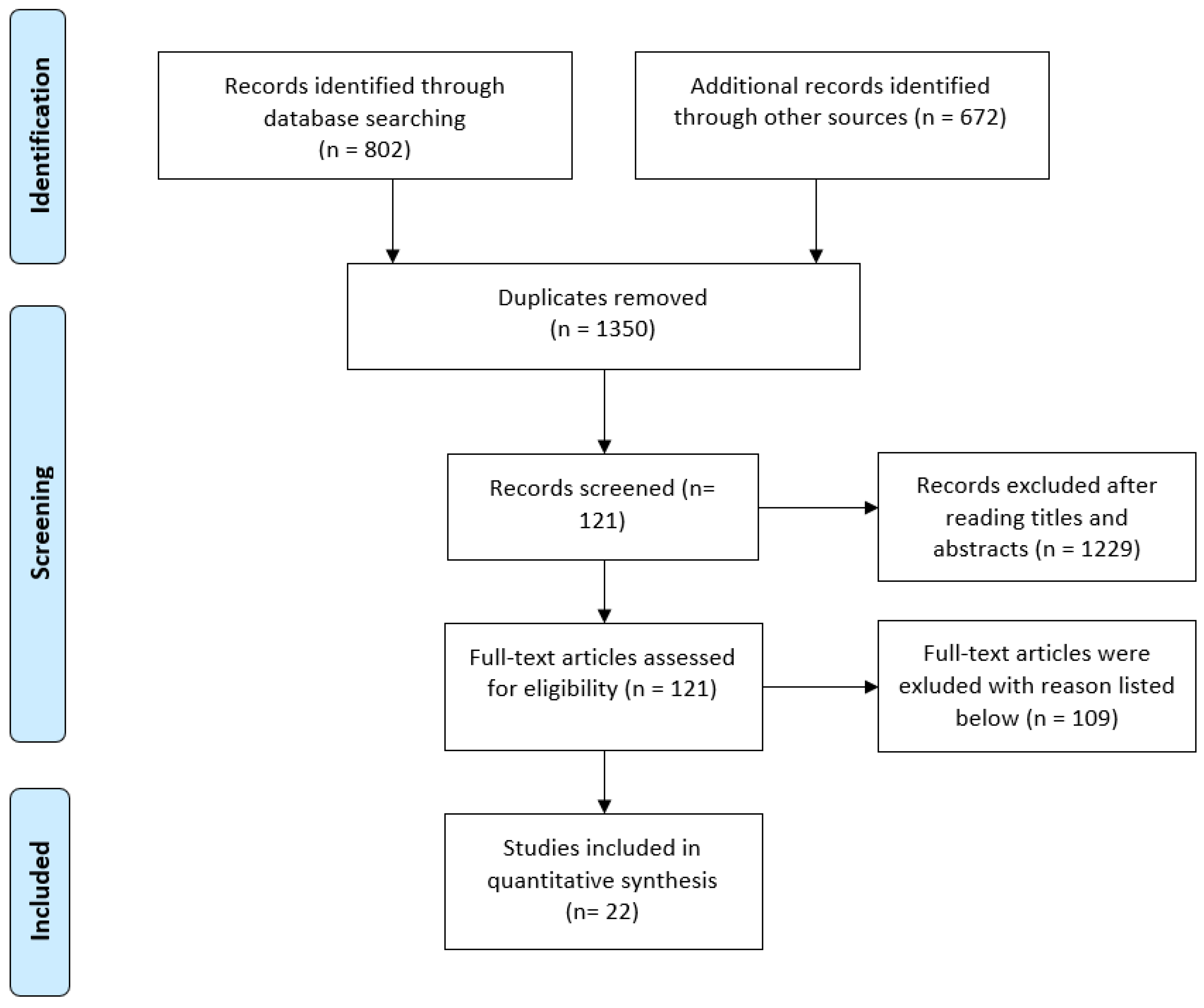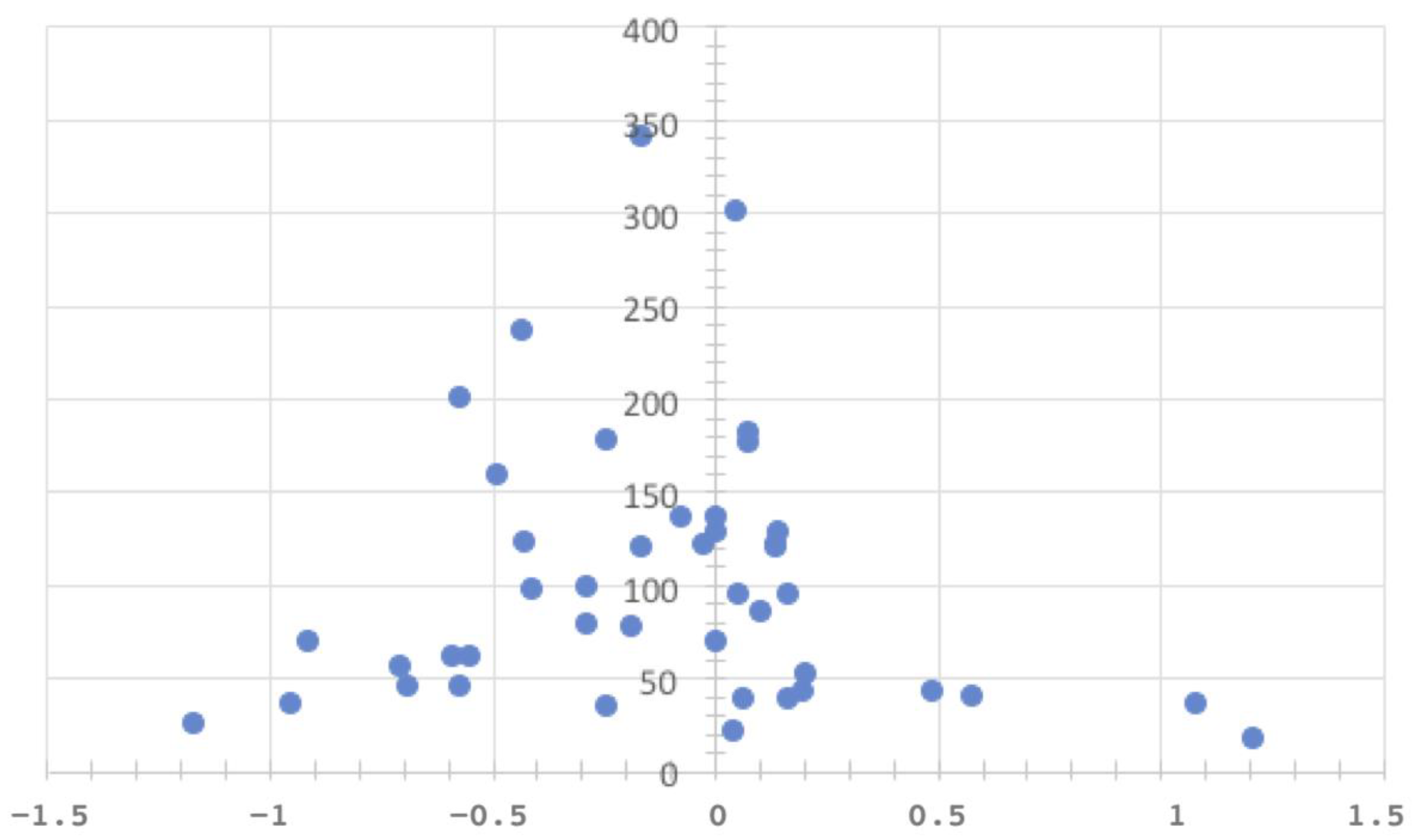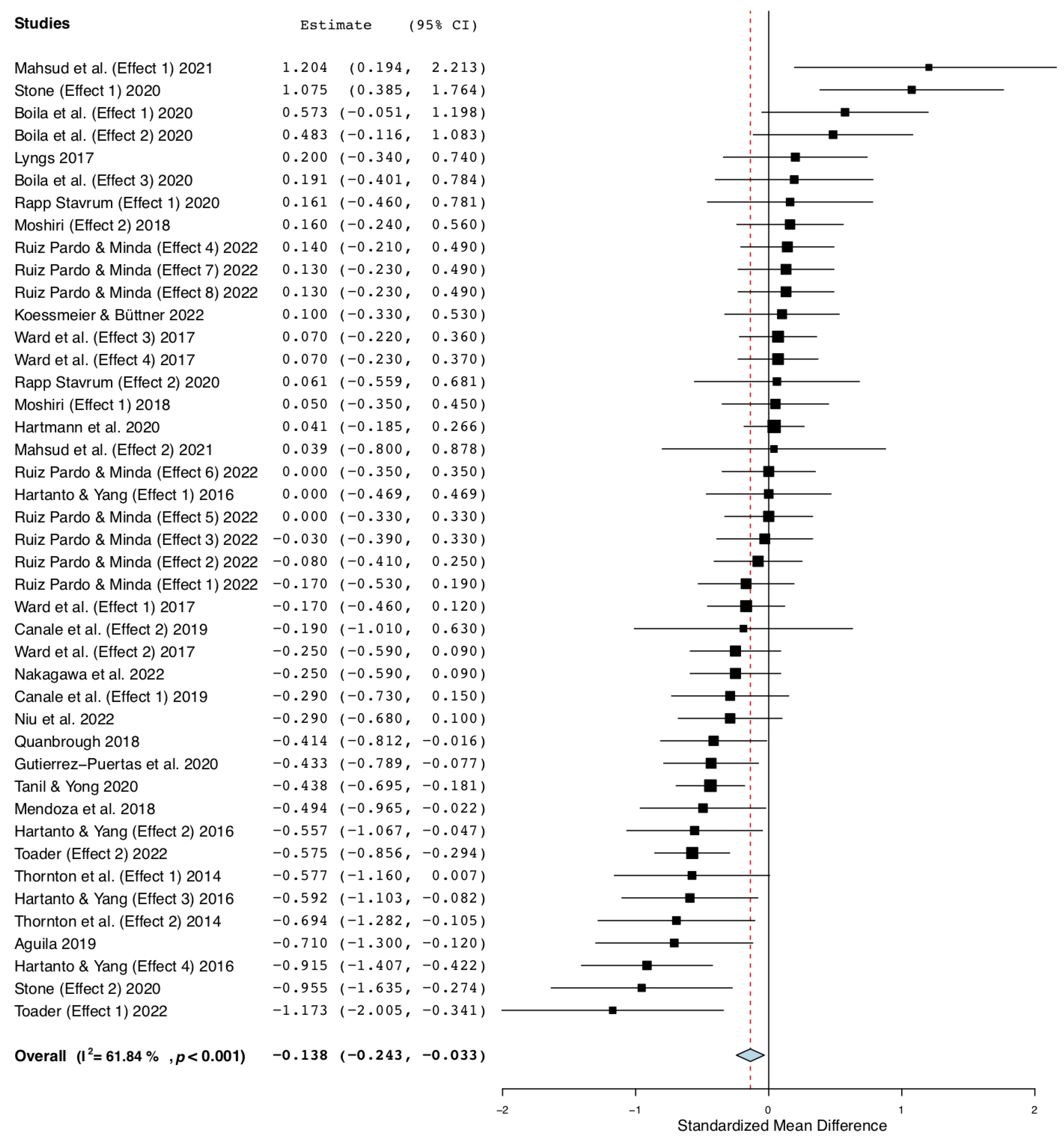Does the Brain Drain Effect Really Exist? A Meta-Analysis
Abstract
:1. Introduction
2. Materials and Methods
3. Results
4. Discussion
Author Contributions
Funding
Data Availability Statement
Conflicts of Interest
Appendix A. Selected Studies with Further Information
| Author/Title | Region | Results | Effects | n | |
| Domain: General cognitive performance | |||||
| Boila, V. C., Kwong, T. E., and Hintz, J. E. (2017) [18] | North America | The group with a cell phone present outperformed the group without a cell phone in all subtests (sentence comprehension, spelling, and math subtest). | Sentence comprehension subtest: phone present (M = 100.45, SD = 10.17) phone absent (M = 98.18, SD = 12.96), t(42) = 0.65, p = 0.52, g = 0.19, 95% CI (−4.82, 9.36) Spelling subtest: phone present (M = 106.71, SD = 6.80) phone absent (M = 102.35, SD = 8.09), t(39) = 1.87, p = 0.07, g = 0.58, 95% CI (−0.35, 9.08) Mathematics subtest: phone present (M = 92.64, SD = 9.05), phone absent (M = 88.32, SD = 8.49), t(42) = 1.63, p = 0.11, g = 0.49, 95% CI (−1.02, 9.66) | 45 | |
| Stone, J. (2020) [8] | North America | Cell phone presence inhibited performance. Cell phone visibility reduces cognitive performance. | Fluid intelligence: desk condition (M = 63.28, SD = 9.10, n = 19) other room (M = 51.55, SD = 12.13, n = 18) t(35) = 3.312, p = 0.002 | 37 | |
| Toader, J. F. et al. (2022) [29] | Europe | The data presented show that distraction by phone calls decreases the performance level of medical students during an OSCE station. | OSCE I (students with both stations n = 13 each): not distracted by phone calls (M = 8.48, SD = 0.89) distracted by telephone calls (M = 7.39, SD = 0.91) OSCE II (students with both wards, n = 101 each): not distracted by phone calls (M = 7.61, SD = 1.16) distracted by telephone calls (M = 6.92, SD = 1.23) | 308 | |
| Domain: Memory | |||||
| Nakagawa, N. et al. (2022) [23] | Asia | The presence of the smartphone did not affect electroencephalography results or working memory. | g = −0.25, 95% CI = −0.58, 0.09 | 36 | |
| Stone, J. (2020) [8] | North America | Results showed that cell phone presence inhibited performance. Cell phone visibility reduces cognitive performance. | Working memory capacity: other room (M = 64.24, SD = 6.05, n = 18) desk condition (M = 57.80, SD = 7.08, n = 19); t(35) = 2.965, p = 0.005 | 37 | |
| Quanbrough, J. (2018) [25] | Europe | The results showed that smartphone presence impaired the participants’ cognitive performance. | Working memory capacity: smartphones present (n = 51, M = 10.43, M = 11.00, SD = 3.00) smartphones absent (n = 48, M = 11.66, M = 12.00, SD = 2.89) (W = 1464.5, p = 0.03, r = −0.22, g = 0.42) | 99 | |
| Tanil, C. T. and Yong, M. H. (2020) [27] | North America | Presence of a smartphone and high phone awareness negatively affect memory learning and recall. | Presence (HS) or absence (LS) of smartphone. LS (M = 14.21, SD = 2.61), HS (M = 13.08, SD = 2.53), t(117) = 2.38, p = 0.02, g = 0.44 | 119 | |
| Hartmann, M., Martarelli, C. S., Reber, T. P., and Rothen, N. (2020) [20] | Europe | No overall effect of smartphone presence on short-term and perspective memory performance. Better performance in participants with low smartphone dependence when smartphone was not present. | F(1, 300) = 0.17, p = 0.676 | 302 | |
| Hartanto, A. and Yang, H. (2016) [21] | Asia | Smartphone absence leads to reduction in working memory capacity. Impairment of mental shifting independent of the extent of smartphone addiction. | Stroop task (assesses inhibitory-control processing): effect of smartphone separation: B = 47.23, p = 0.028 Rotation span test (working-memory capacity): effect of smartphone separation: t(60) = 1.98, p = 0.052, g = 0.52 | 70 | |
| Ward, A. F., Duke, K., Gneezy, A., and Bos, M. W. (2017) [3] | North America | The mere presence of smartphones can negatively affect the available capacity of working memory. | Effect 1: g = −0.17, 95% CI = −0.47, 0.12 Effect 2: g = −0.25, 95% CI = −0.58, 0.09 | 521 | |
| Niu, G. et al. (2022) [24] | Asia | The presence of smartphones has a negative impact on cognitive functions. | g = −0.29, 95% CI = −0.68, 0.10 | 100 | |
| Canale, N., Vieno, A., Doro, M., Rosa Mineo, E., Marino, C., and Billieux, J. (2019) [22] | Europe | Turned-on devices had a detrimental effect on subjects’ task performance. | Effect 1: g = −0.29, 95% CI = −0.73, 0.15 Effect 2: g = −0.19, 95% CI = −0.25, 0.63 | 159 | |
| Ruiz Pardo, A., and Minda, J. (2022) [18] | North America | The mere presence of the smartphone is not enough to affect cognitive performance. | Effect 1: g = −0.17, 95% CI = −0.52, 0.19 Effect 2: g = −0.08, 95% CI = −0.42, 0.25 Effect 3: g = −0.03, 95% CI = −0.38, 0.33 Effect 4: g = 0.14, 95% CI = −0.21, 0.49 | 511 | |
| Domain: Attention | |||||
| Aguila, B. (2019) [31] | North America | Presence of a cell phone led to poorer performance among participants with smartphones in close proximity. | g = −0.71, 95% CI = −1.30, −0.12 | 57 | |
| Ruiz Pardo, A., and Minda, J. (2022) [18] | North America | The mere presence of the smartphone is not enough to affect cognitive performance. | Effect 5: g = 0.00, 95% CI = −0.33, 0.33 Effect 6: g = 0.00, 95% CI = −0.35, 0.35 Effect 7: g = 0.13, 95% CI = −0.22, 0.49 Effect 8: g = 0.13, 95% CI = −0.22, 0.49 | 511 | |
| Moshiri, J. (2018) [17] | North America | Smartphone presence had no significant effect on cognitive performance. | Effect 1: g = 0.05, 95% CI = −0.35, 0.45 Effect 2: g = 0.16, 95% CI = −0.24, 0.56 | 192 | |
| Ward, A. F., Duke, K., Gneezy, A. and Bos, M. W. (2017) [3] | North America | Presence of smartphone can tax cognitive resources, leaving fewer resources available for other tasks and impairing cognitive performance. | Effect 3: g = 0.07, 95% CI = −0.22, 0.36 Effect 4: g = 0.07, 95% CI = −0.22, 0.37 | 361 | |
| Koessmeier, C. and Büttner, O. (2022) [19] | Europe | Presence of the smartphone without influence on task performance. | g = 0.10, 95% CI = −0.32, 0.53 | 86 | |
| Lyngs, U. (2017) [15] | Europe | Presence of smartphone without influence on task performance. | g = 0.20, 95% CI = −0.34, 0.74 | 53 | |
| Thornton, B., Faires, A., Robbins, M., and Rollins, E. (2014) [30] | North America | Mere presence of a cell phone sufficiently distracting to lead to decreased attention and deficits in task performance, especially in tasks with higher attentional and cognitive demands. | Digit cancellations: cell phone present (experimental group, M = 21.29) no cell phone present (M = 26.17) F(1, 45) = 5.80, p < 0.05, g2 p = 0.11 Trail making tests: more difficult Part B: phone present (M = 14.50) phone not present (M = 16.91) F(1, 45) = 4.05, p = 0.05, g2 p = 0.08 | 54 | |
| Gutierrez-Puertas et al. (2020) [26] | Europe | More attentive in class without access to cell phones. | Mindful attention awareness scale: smartphone absent (M = 54.17, SD = 14.30, n = 63) smartphone present, M = 48.27, SD = 12.71, n = 61) | 124 | |
| Mahsud, M., Khaaf, A. J. M., Mahsud, Z., Afzal, A., Afzal, F. (2021) [9] | Asia/Europe | Concentration disturbed by smartphones. Asian concentrate better without smartphones. European students became restless without smartphones. | European students (n = 18): without smartphone: M = 4.7, SD = 3.34 with smartphone: M = 8.25, SD = 1.92 Asian students (n = 22): without smartphone: M = 5, SD = 2.44 with smartphone: M = 5.25, SD = 8.02 | 40 | |
| Stavrum, M. (2020) [16] | North America | No statistically significant effect of smartphone availability on performance. | Raven’s Standard Progressive Matrices: smartphone present (M = 27.45, SD = 1.78) smartphone absent (M = 27.15, SD = 1.88) Spanboard Test: smartphone present (M = 6.6, SD = 1.78) smartphone absent (M = 6.5, SD = 1.39) | 40 | |
| Mendoza, J. S., Pody, B. C., Lee, S., Kim, M., and McDonough, I. M. (2018) [28] | North America | Participants distracted by the smartphone performed worse in the test than those who were not distracted. | Main effect of group was found: F(1158) = 7.51, MSE = 0.029, p = 0.007, h2p = 0.05 Quiz performance: cellphones removed (M = 0.65, SD = 0.17) cellphones retained (M = 0.57, SD = 0.16) | 160 | |
| Note. n = number of observations. | |||||
References
- Bavarian State Ministry of Education and Cultural Affairs. Schulen Erhalten mehr Spielraum beim Privaten Einsatz von Handys. Available online: https://www.km.bayern.de/eltern/meldung/7613/schulen-erhalten-mehr-spielraum-beim-privaten-einsatz-von-handys.html (accessed on 6 August 2023).
- Carros; Joeres, A. Ohne Smartphone in Die Schule-ja, das Geht. Zeit Online. Available online: https://www.zeit.de/gesellschaft/schule/2018-10/handyverbot-frankreich-schule-bildung/seite-2 (accessed on 16 February 2023).
- Ward, A.F.; Duke, K.; Gneezy, A.; Bos, M.W. Brain Drain: The Mere Presence of One’s Own Smartphone Reduces Available Cognitive Capacity. J. Assoc. Consum. Res. 2017, 2, 140–154. [Google Scholar] [CrossRef]
- Froese, A.D.; Carpenter, C.N.; Inman, D.A.; Schooley, J.R.; Barnes, R.B.; Brecht, P.W.; Chacon, J.D. Effects of classroom cell phone use on expected and actual learning. Coll. Stud. J. 2012, 46, 323–332. [Google Scholar]
- Al-Khlaiwi, T.M.; Habib, S.S.; Meo, S.A.; Alqhtani, M.S.; Ogailan, A.A. The association of smart mobile phone usage with cognitive function impairment in Saudi adult population. Pak. J. Med. Sci. 2020, 36, 1628–1633. [Google Scholar] [CrossRef] [PubMed]
- Engle, R.W. Working Memory Capacity as Executive Attention. Curr. Dir. Psychol. Sci. 2002, 11, 19–23. [Google Scholar] [CrossRef]
- Stothart, C.; Mitchum, A.; Yehnert, C. The attentional cost of receiving a cell phone notification. J. Exp. Psychol. Hum. Percept. Perform. 2015, 41, 893–897. [Google Scholar] [CrossRef] [PubMed]
- Stone, J. Smartphones, Stress, and the Reduction of Cognitive Ressources. Master’s Thesis, Southern University, Statesboro, Georgia, 2020. [Google Scholar]
- Mahsud, M.; Khalaf, A.J.M.; Mahsud, Z.; Afzal, A.; Afzal, F. Addiction to smartphones leading to distraction in the classrooms: Effect of different cultures. J. Stat. Manag. Syst. 2020, 24, 741–754. [Google Scholar] [CrossRef]
- Bianchi, A.; Phillips, J.G. Psychological predictors of problem mobile phone use. Cyberpsychol. Behav. Impact Internet Multimed. Virtual Real. Behav. Soc. 2005, 8, 39–51. [Google Scholar] [CrossRef]
- Zubko, O.; Gould, R.L.; Gay, H.C.; Cox, H.J.; Coulson, M.C.; Howard, R.J. Effects of electromagnetic fields emitted by GSM phones on working memory: A meta-analysis. Int. J. Geriatr. Psychiatry 2016, 32, 125–135. [Google Scholar] [CrossRef] [PubMed]
- George, M.J.; Odgers, C.L. Seven Fears and the Science of How Mobile Technologies May Be Influencing Adolescents in the Digital Age. Perspect. Psychol. Sci. 2015, 10, 832–851. [Google Scholar] [CrossRef]
- Dan, J.; Bowden, J.; Baker, R. How does the DerSimonian and Laird procedure for random effects meta-analysis compare with ist more efficient but harder to compute counterparts? J. Stat. Plan. Inference 2010, 140, 961–970. [Google Scholar]
- Boila, V.C.; Kwong, T.E.; Hintz, J.E. Mere Presence of a Cell Phone: Effects on Academic Ability. Behav. Sci. Undergrad. J. 2017, 3, 18–30. [Google Scholar] [CrossRef]
- Lyngs, U. “It’s more fun with my phone”: A replication study of cell phone presence and task performance. In CHI’17 Extended Abstracts; Association for Computing Machinery: New York, NY, USA, 2017; pp. 136–141. [Google Scholar]
- Stavrum, M. Testing the Brain Drain Hypothesis: Effects of Smartphone Presence on Working Memory. Master’s Thesis, Norwegian University of Science and Technology, Trondheim, Norway, 2020. [Google Scholar]
- Moshiri, J. Cognitive Costs of Being Near Your iPhone. Master’s Thesis, California State University, Northridge, Los Angeles, CA, USA, 2018. [Google Scholar]
- Ruiz Pardo, A.; Minda, J. Reexamining the “brain drain” effect: A replication of Ward et al. (2017). Acta Psychol. 2022, 230, 103717. [Google Scholar] [CrossRef] [PubMed]
- Koessmeier, C.; Büttner, O. Beyond the smartphone’s mere presence effect: A quantitative mobile eye tracking study on the visual and internal distraction potential of smartphones. Comput. Hum. Behav. 2022, 134, 107333. [Google Scholar] [CrossRef]
- Hartmann, M.; Martarelli, C.S.; Reber, T.P.; Rothen, N. Does a smartphone on the desk drain our brain? No evidence of cognitive costs due to smartphone presence in a short-term and prospective memory task. Conscious. Cogn. 2020, 86, 103033. [Google Scholar] [CrossRef] [PubMed]
- Hartanto, A.; Yang, H. Is the smartphone a smart choice? The effect of smartphone separation on executive functions. Comput. Hum. Behav. 2016, 64, 329–336. [Google Scholar] [CrossRef]
- Canale, N.; Vieno, A.; Doro, M.; Rosa Mineo, E.; Marino, C.; Billieux, J. Emotion-related impulsivity moderates the cognitive interference effect of smartphone availability on working memory. Sci. Rep. 2019, 9, 18519. [Google Scholar] [CrossRef]
- Nakagawa, N.; Odanaka, K.; Ohara, H.; Ito, T.; Kisara, S.; Ito, K. Effect of smartphone location on pharmacy students’ attention and working memory. J. Adv. Pharm. Educ. Res. 2022, 12, 84–90. [Google Scholar] [CrossRef]
- Niu, G.F.; Shi, X.H.; Yang, W.C.; Jin, S.Y.; Sun, X.J. Smartphone presence affect cognitive function? The moderating role of fear of missing out. Comput. Hum. Behav. 2022, 136, 107399. [Google Scholar] [CrossRef]
- Quanbrough, J. Brain Drain Revisited: Smartphone Presence and Its Effects on Cognitive Performance in the Light of Smartphone Attachment and Fear of Missing out. Master’s Thesis, University of Basel, Basel, Switzerland, 2018. [Google Scholar]
- Gutierrez-Puertas, L.; Márquez-Hernández, V.V.; Gutiérrez-Puertas, V.; Granados-Gámez, G.; Aguilera-Manrique, G. The effect of cell phones on attention and learning in nursing students. Comput. Inform. Nurs. 2020, 38, 408–414. [Google Scholar] [CrossRef]
- Tanil, C.T.; Yong, M.H. Mobile phones: The effect of its presence on learning and memory. PLoS ONE 2020, 15, e0219233. [Google Scholar] [CrossRef]
- Mendoza, J.S.; Pody, B.C.; Lee, S.; Kim, M.; McDonough, I.M. The effect of cellphones on attention and learning: The influences of time, distraction, and nomophobia. Comput. Hum. Behav. 2018, 86, 52–60. [Google Scholar] [CrossRef]
- Toader, J.F.; Kleinert, R.; Dratsch, T.; Fettweis, L.; Jakovljevic, N.; Graupner, M.; Zeeh, M.; Kroll, A.C.; Fuchs, H.F.; Wahba, R.; et al. Effect of phone call distraction on the performance of medical students in an OSCE. BMC Med. Educ. 2022, 22, 295. [Google Scholar] [CrossRef] [PubMed]
- Thornton, B.; Faires, A.; Robbins, M.; Rollins, E. The Mere Presence of a Cell Phone May be Distracting. Soc. Psychol. 2014, 45, 479–488. [Google Scholar] [CrossRef]
- Aguila, B. Codependency Traits and the Mere Presence of a Cell Phone. Master’s Thesis, Eastern Washington University, Cheney, WA, USA, 2019. [Google Scholar]
- Fiebig, J.; Gerrit, R.; Urban, D. Meta-Analyse und “Publication Bias”. Eine Empirische Fallstudie. Schriftenreihe des Instituts für Sozialwissenschaften der Universität Stuttgart—SISS. 2012. Available online: https://www.sowi.uni-stuttgart.de/dokumente/forschung/siss/2012.SISS.1.pdf (accessed on 6 August 2023).
- Baulig, C.; Knippschild, S.; Krummenauer, F. Meta-Analysen und Forest Plot—Mehrere Studien wissen mehr als ein. Dtsch. Ärzte-Verl. 2015, 31, 158–162. [Google Scholar]
- Petitti, D.B. Approaches to heterogeneity in meta-analysis. Stat. Med. 2001, 20, 3625–3633. [Google Scholar] [CrossRef] [PubMed]
- Zierer, K. Putting Learning before Technology; Routledge: London, UK, 2020. [Google Scholar]
- UNESCO. Technology in Education. Global Education Monitoring Report. Available online: https://www.unesco.org/gem-report/en/technology (accessed on 6 August 2023).


| Factor | Q (df) | I2 |
|---|---|---|
| Memory | 36.14 ** (17) | 52.96 |
| Attention | 32.30 * (18) | 44.29 |
| General cognitive performance | 37.37 ** (5) | 86.62 |
| Factor | Q (df) | I2 |
|---|---|---|
| North America | 48.96 ** (24) | 50.98 |
| Europe | 30.73 ** (9) | 70.71 |
| Asia | 10.08 (5) | 30.58 |
Disclaimer/Publisher’s Note: The statements, opinions and data contained in all publications are solely those of the individual author(s) and contributor(s) and not of MDPI and/or the editor(s). MDPI and/or the editor(s) disclaim responsibility for any injury to people or property resulting from any ideas, methods, instructions or products referred to in the content. |
© 2023 by the authors. Licensee MDPI, Basel, Switzerland. This article is an open access article distributed under the terms and conditions of the Creative Commons Attribution (CC BY) license (https://creativecommons.org/licenses/by/4.0/).
Share and Cite
Böttger, T.; Poschik, M.; Zierer, K. Does the Brain Drain Effect Really Exist? A Meta-Analysis. Behav. Sci. 2023, 13, 751. https://doi.org/10.3390/bs13090751
Böttger T, Poschik M, Zierer K. Does the Brain Drain Effect Really Exist? A Meta-Analysis. Behavioral Sciences. 2023; 13(9):751. https://doi.org/10.3390/bs13090751
Chicago/Turabian StyleBöttger, Tobias, Michael Poschik, and Klaus Zierer. 2023. "Does the Brain Drain Effect Really Exist? A Meta-Analysis" Behavioral Sciences 13, no. 9: 751. https://doi.org/10.3390/bs13090751
APA StyleBöttger, T., Poschik, M., & Zierer, K. (2023). Does the Brain Drain Effect Really Exist? A Meta-Analysis. Behavioral Sciences, 13(9), 751. https://doi.org/10.3390/bs13090751







